Effect of Thermally Reduced Graphene Oxide on Mechanical Properties of Woven Carbon Fiber/Epoxy Composite
Abstract
:1. Introduction
2. Experimental
2.1. Materials
2.2. Fabrication of TRGO/CF/Epoxy Laminate
2.3. Characterization
3. Results and Discussions
3.1. Structural and Morphological Study of TRGO
3.2. Effects of TRGO on the Viscoelastic Properties of Epoxy Resin
3.3. Fracture Surface Morphology Analysis
3.4. Volume Fraction of the Constituents
3.5. Interlaminar Shear Strength (ILSS)
3.6. Plane-Strain Fracture Toughness
3.7. ImpactProperties Analysis
4. Conclusions
Acknowledgments
Author Contributions
Conflicts of Interest
References
- Kim, J.K.; Mai, Y.W. High strength, high fracture toughness fibre composites with interface control-a review. Compos. Sci. Technol. 1991, 41, 333–378. [Google Scholar] [CrossRef]
- Adak, N.C.; Chhetri, S.; Kim, N.H.; Murmu, N.C.; Samanta, P.; Kuila, T. Static and Dynamic Mechanical Properties of Graphene Oxide-Incorporated Woven Carbon Fiber/Epoxy Composite. J. Mater. Eng. Perform. 2018. [Google Scholar] [CrossRef]
- Jin, J.C.; Sun, C.T. Prediction of delamination in composite laminates subjected to low velocity impact. J. Compos. Mater. 1993, 27, 684–701. [Google Scholar]
- Choi, N.S.; Kinloch, A.J.; Williams, J.G. Delamination fracture of multidirectional carbon-fiber/epoxy composites under Mode I. Mode II and mixed-Mode I/II loading. J. Compos. Mater. 1999, 33, 73–99. [Google Scholar] [CrossRef]
- James, R.; Song, R.K.; Chunchu, P.; Ambur, D.R. Postbukling and growth of delamination in composite plates subjected to axial compression. In Proceedings of the 43rd AIAA/ASME/ASCE/AHS/ASC Structures, Structural Dynamics, and Materials Conference, Denver, CO, USA, 22–25 April 2002; p. 1746. [Google Scholar]
- Greenhalgh, E.S.; Rogers, C.; Robinson, P. Fractographic observations on delamination growth and the subsequent migration through the laminate. Compos. Sci. Technol. 2009, 69, 2345–2351. [Google Scholar] [CrossRef]
- Greenhalgh, E.S. Woodhead Publishing Series in Composites Science and Engineering; CRC Press: Boca Raton, FL, USA, 2009; pp. 164–165. [Google Scholar]
- Chen, C.Z.; Li, Y.; Yu, T. Interlaminar toughening in flax fiber-reinforced composites interleaved with carbon nanotube buckypaper. J. Reinf. Plast. Compos. 2014, 33, 1859–1868. [Google Scholar] [CrossRef]
- Palazzetti, R.; Zucchelli, A.; Gualandi, C.; Focarete, M.L.; Donati, L.; Minak, G.; Ramakrishna, S. Influence of electrospun Nylon 6,6 nanofibrous mats on the interlaminar properties of Gr–epoxy composite laminates. Compos. Struct. 2012, 94, 571–579. [Google Scholar] [CrossRef]
- Jiang, W.; Tjong, S.C.; Chu, P.K.; Li, R.K.Y.; Kim, J.K.; Mai, Y.-W. Interlaminar fracture properties of carbon fibre/epoxy matrix composites interleaved with polyethylene terephthalate (PET) films. Polym. Polym. Compos. 2001, 9, 141–145. [Google Scholar]
- Yuna, N.G.; Wona, Y.G.; Kimb, S.C. Toughening of carbon fiber/epoxy composite by inserting polysulfone film to form morphology spectrum. Polymer 2004, 45, 6953–6958. [Google Scholar] [CrossRef]
- White, K.L.; Sue, H.J. Structural composites hybridized with epoxy compatible polymer/MWCNT nanofibrous interlayers. Polymer 2012, 53, 37–42. [Google Scholar] [CrossRef]
- Dzenis, Y.; Reneker, D. Delamination Resistant Composite Prepared by Small Diameter Fiber Reinforcement at Ply Interfaces. U.S. Patent No. 6,265,333, 24 July 2001. [Google Scholar]
- Sihn, S.; Kim, R.Y.; Huh, W.; Lee, K.H.; Roy, A.K. Improvement of damage resistance in laminated composites with electrospunnano-interlayers. Compos. Sci. Technol. 2008, 68, 673–683. [Google Scholar] [CrossRef]
- Lingaiah, S.; Shivakumar, K.N.; Sadler, R.; Sharpe, M. Electrospinning of nylon-66 polymer Nanofabrics. In Proceedings of the 49th AIAA/ASME/ASCE/AHS/ASC Structures, Structural Dynamics and Materials Conference, Honolulu, HI, USA, 7–10 April 2008; p. 1. [Google Scholar]
- Heijden, S.V.; Daelemans, L.D.; Schoenmaker, B.D. Interlaminar toughening of resin transfer moulded glass fibre epoxy laminates by polycaprolactoneelectrospunnanofibers. Compos. Sci. Technol. 2014, 104, 66–73. [Google Scholar] [CrossRef]
- Zhang, J.; Lin, T.; Wang, X. Electrospunnanofibre toughened carbon/epoxy composites: Effects of polyetherketonecardo (PEK-C) nanofibre diameter and interlayer thickness. Compos. Sci. Technol. 2010, 70, 1660–1666. [Google Scholar] [CrossRef]
- Magniez, K.; Chaffraix, T.; Fox, B. Toughening of a Carbon-Fibre Composite Using Electrospun Poly(Hydroxyether of Bisphenol A) Nanofibrous Membranes Through Inverse Phase Separation and Inter-Domain Etherification. Materials 2011, 4, 1967–1984. [Google Scholar] [CrossRef] [PubMed]
- Zheng, N.; Huang, Y.; Liu, H.Y.; Gao, J.; Mai, Y.W. Improvement of interlaminar fracture toughness in carbon fiber/epoxy composites with carbon nanotubes/polysulfone interleaves. Compos. Sci. Technol. 2017, 140, 8–15. [Google Scholar] [CrossRef]
- Todo, M.; Jar, P.Y.B. Study of mode I interlaminar crack growth of fibre reinforced composites using DCB specimens. Compos. Sci. Technol. 1998, 58, 105–118. [Google Scholar] [CrossRef]
- Singh, S.; Partridge, I.K. Delamination failure in unidirectional carbon fibre/epoxy under mixed mode loading. Polym. Polym. Compos. 1995, 3, 35–39. [Google Scholar]
- Hwang, S.F.; Shen, B.C. Opening-mode interlaminar fracture toughness of interplyhybride composite materials. Compos. Sci. Technol. 1999, 59, 1861–1869. [Google Scholar] [CrossRef]
- Rocha, R.M.; Cairo, C.A.A.; Graca, M.L.A. Formation of carbon fiber-reinforced ceramic matrix composites with polysiloxane/silicon derived matrix. Mater. Sci. Eng. 2006, 437, 268–273. [Google Scholar] [CrossRef]
- Kachold, F.; Singer, R. Mechanical Properties of Carbon Fiber-Reinforced Aluminum Manufactured by High-Pressure Die Casting. J. Mater. Eng. Perform. 2016, 25, 3128–3133. [Google Scholar] [CrossRef]
- Cai, F.; Gao, F.; Pant, S.; Huang, X.; Yang, Q. Solid Particle Erosion Behaviors of Carbon-Fiber Epoxy Composite and Pure Titanium. J. Mater. Eng. Perform. 2016, 25, 290–296. [Google Scholar] [CrossRef]
- Spitalsky, Z.; Tasis, D.; Papagelis, K.; Galiotis, C. Carbon nanotube-polymer composites: Chemistry, processing, mechanical and electrical properties. Prog. Polym. Sci. 2010, 35, 357–401. [Google Scholar] [CrossRef]
- Liu, N.; Luo, F.; Wu, H.; Liu, Y.; Zhang, C.; Chen, J. Onestep ionic-liquid-assisted electrochemical synthesis of ionicliquid-functionalized graphene sheets directly from graphite. Adv. Funct. Mater. 2008, 18, 1518–1525. [Google Scholar] [CrossRef]
- Zeng, S.; Hoisington, M.; Seferis, J.C. Particulate interlayer toughening of dicyanate matrix composites. Polym. Compos. 1993, 14, 458–466. [Google Scholar] [CrossRef]
- Arai, M.; Noro, Y.; Sugimoto, K.I.; Endo, M. Mode I and mode II interlaminar fracture toughness of CFRP laminates toughened by carbon nanofiber interlayer. Compos. Sci. Technol. 2008, 68, 516–525. [Google Scholar] [CrossRef]
- Karapappas, P.; Vavouliotis, A.; Tsotra, P.; Kostopoulos, V.; Paipetis, A. Enhanced fracture properties of carbon reinforced composites by the addition of multi-wall carbon nanotubes. J. Compos. Mater. 2009, 43, 977–985. [Google Scholar] [CrossRef]
- Seyhan, A.T.; Tanoglu, M.; Schulte, K. Mode I and mode II fracture toughness of E-glass non-crimp fabric/carbon nanotube (CNT) modified polymer based composites. Eng. Fract. Mech. 2008, 75, 5151–5162. [Google Scholar] [CrossRef]
- Tang, L.C.; Zhang, H.; Han, J.H.; Wu, X.P.; Zhang, Z. Fracture mechanisms of epoxy filled with ozone functionalized multi-wall carbon nanotubes. Compos. Sci. Technol. 2011, 72, 7–13. [Google Scholar] [CrossRef]
- Esposito, L.H.; Ramos, J.A.; Kortaberria, G. Dispersion of carbon nanotubes in nanostructured epoxy systems for coating application. Prog. Org. Coat. 2014, 77, 1452–1458. [Google Scholar] [CrossRef]
- Rafiee, M.A.; Rafiee, J.; Wang, Z.; Song, H.H.; Yu, Z.Z.; Koratkar, N. Enhanced Mechanical Properties of Nanocomposites at Low Graphene Content. ACS Nano 2009, 3, 3884–3890. [Google Scholar] [CrossRef] [PubMed]
- Stankovich, S.; Dikin, D.A.; Dommett, G.H.B.; Kohlhaas, K.M.; Zimney, E.J.; Stach, E.A.; Piner, R.D.; Nguyen, S.T.; Ruoff, R.S. Graphene-based composite materials. Nature 2006, 442, 282–286. [Google Scholar] [CrossRef] [PubMed]
- Du, S.S.; Li, F.; Xiao, H.M.; Li, Y.Q.; Hu, N.; Fu, S.Y. Tensile and flexural properties of graphene oxide coated-short glass fiber reinforced polyethersulfone composites. Compos. Part B 2016, 99, 407–415. [Google Scholar] [CrossRef]
- Kwon, Y.J.; Kim, Y.; Jeon, H.; Cho, S.; Lee, W.; Lee, J.U. Graphene/carbon nanotube hybrid as a multi-functional interfacial reinforcement for carbon fiber-reinforced composites. Compos. Part B 2017, 122, 23–30. [Google Scholar] [CrossRef]
- Lee, W.; Lee, J.U.; Cha, H.J.; Byun, J.H. Partially reduced graphene oxide as a multi-functional sizing agent for carbon fiber composites by electrophoretic deposition. RSC Adv. 2013, 3, 25609–25613. [Google Scholar] [CrossRef]
- Qin, W.; Vautard, F.; Drzal, L.T.; Yu, J. Mechanical and Electrical Properties of Carbon Fiber Composites with Incorporation of Graphene Nanoplatelets at the Fiber-Matrix Interphase. Compos. Part B 2015, 69, 335–341. [Google Scholar] [CrossRef]
- Shen, X.J.; Meng, L.X.; Yan, Z.Y.; Sun, C.J.; Ji, Y.H.; Xiao, H.M.; Fu, S.Y. Improved cryogenic interlaminar shear strength of glass fabric/epoxy composites by graphene oxide. Compos. Part B 2015, 73, 126–131. [Google Scholar] [CrossRef]
- Yavari, F.; Rafiee, M.A.; Rafiee, J.; Yu, Z.Z.; Koratkar, N. Dramatic Increase in Fatigue Life in Hierarchical Graphene Composites. ACS Appl. Mater. Interfaces 2010, 10, 2738–2743. [Google Scholar] [CrossRef] [PubMed]
- Zhang, X.; Fan, X.; Yan, C.; Li, H.; Zhu, Y.; Li, X.; Yu, L. Interfacial Microstructure and Properties of Carbon Fiber Composites Modified with Graphene Oxide. ACS Appl. Mater. Interfaces 2012, 4, 1543–1552. [Google Scholar] [CrossRef] [PubMed]
- Kuila, T.; Bose, S.; Khanra, P.; Mishra, A.K.; Kim, N.H.; Lee, J.H. A green approach for the reduction of graphene oxide by wild carrot root. Carbon 2012, 50, 914–921. [Google Scholar] [CrossRef]
- Liu, X.; Qi, X.; Zhang, Z.; Ren, L.; Hao, G.; Liu, Y.; Wang, Y.; Huang, K.; Wei, X.; Li, J.; et al. Electrochemically reduced graphene oxide with porous structure as a binder-free electrode for high-rate supercapacitors. RSC Adv. 2014, 4, 13673–13679. [Google Scholar] [CrossRef]
- Mou, Z.; Chen, X.; Du, Y.; Wang, X.; Yang, P.; Wang, S. Forming mechanism of nitrogen doped graphene prepared by thermal solid-state reaction of graphite oxide and urea. Appl. Surf. Sci. 2011, 258, 1704–1710. [Google Scholar] [CrossRef]
- Park, B.Y.; Kim, W.S.C.; Jung, B. Interlaminar Fracture Toughness of Carbon Fiber/Epoxy Composites using Short Kevlar Fiber and/or Nylon-6 Powder Reinforcement. Polym. Adv. Technol. 1997, 8, 371–377. [Google Scholar] [CrossRef]
- Davis, D.C.; Whelan, B.D. An experimental study of interlaminar shear fracture toughness of a nanotube reinforced composite. Compos. Part B Eng. 2011, 42, 105–116. [Google Scholar] [CrossRef]
- Chhetri, S.; Adak, N.C.; Samanta, P.; Mallisetty, P.K.; Murmu, N.C.; Kuila, T. Interface engineering for the improvement of mechanical and thermal properties of covalent functionalized graphene/epoxy composites. J. Appl. Polym. Sci. 2017, 46124, 1–10. [Google Scholar] [CrossRef]
- Chhetri, S.; Adak, N.C.; Samanta, P.; Murmu, N.C.; Kuila, T. Functionalized reduced graphene oxide/epoxy composites with enhanced mechanical properties and thermal stability. Polym. Test. 2017, 63, 1–11. [Google Scholar] [CrossRef]
- Zhang, Z.Y.; Richardson, M.O.W. Low velocity impact induced damage evaluation and its effect on the residual flexural properties of pultruded GRP composites. Compos. Struct. 2007, 81, 195–201. [Google Scholar] [CrossRef]
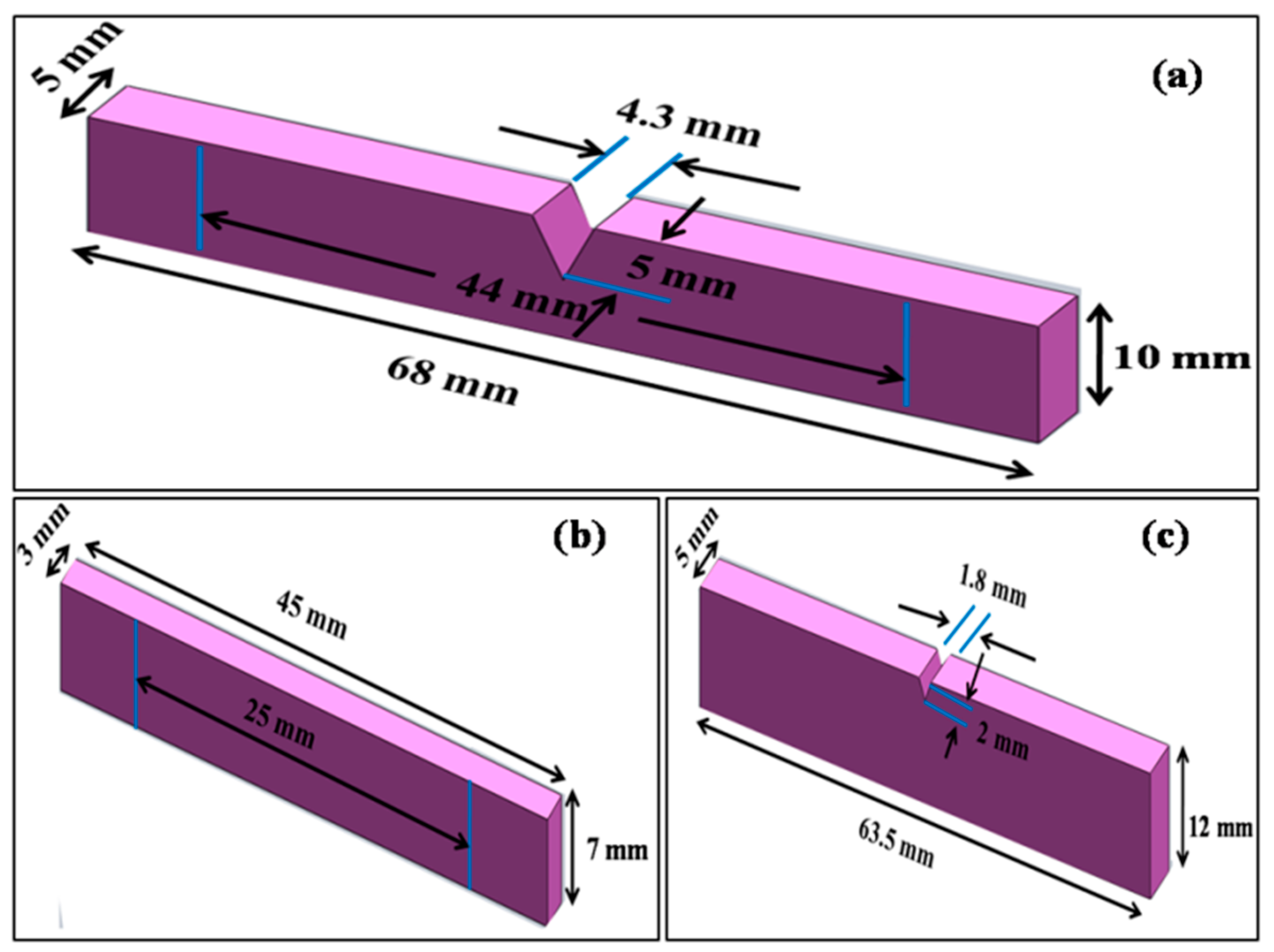

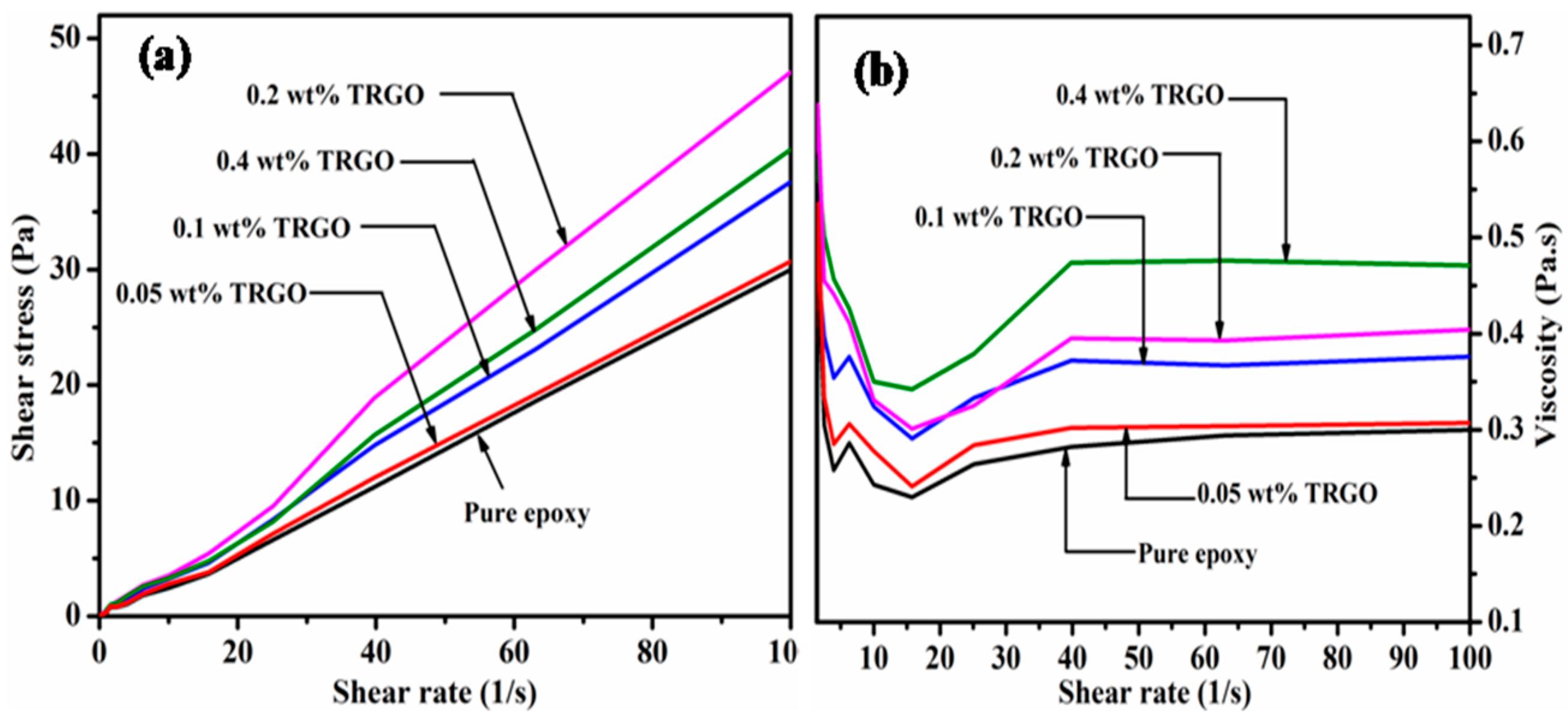
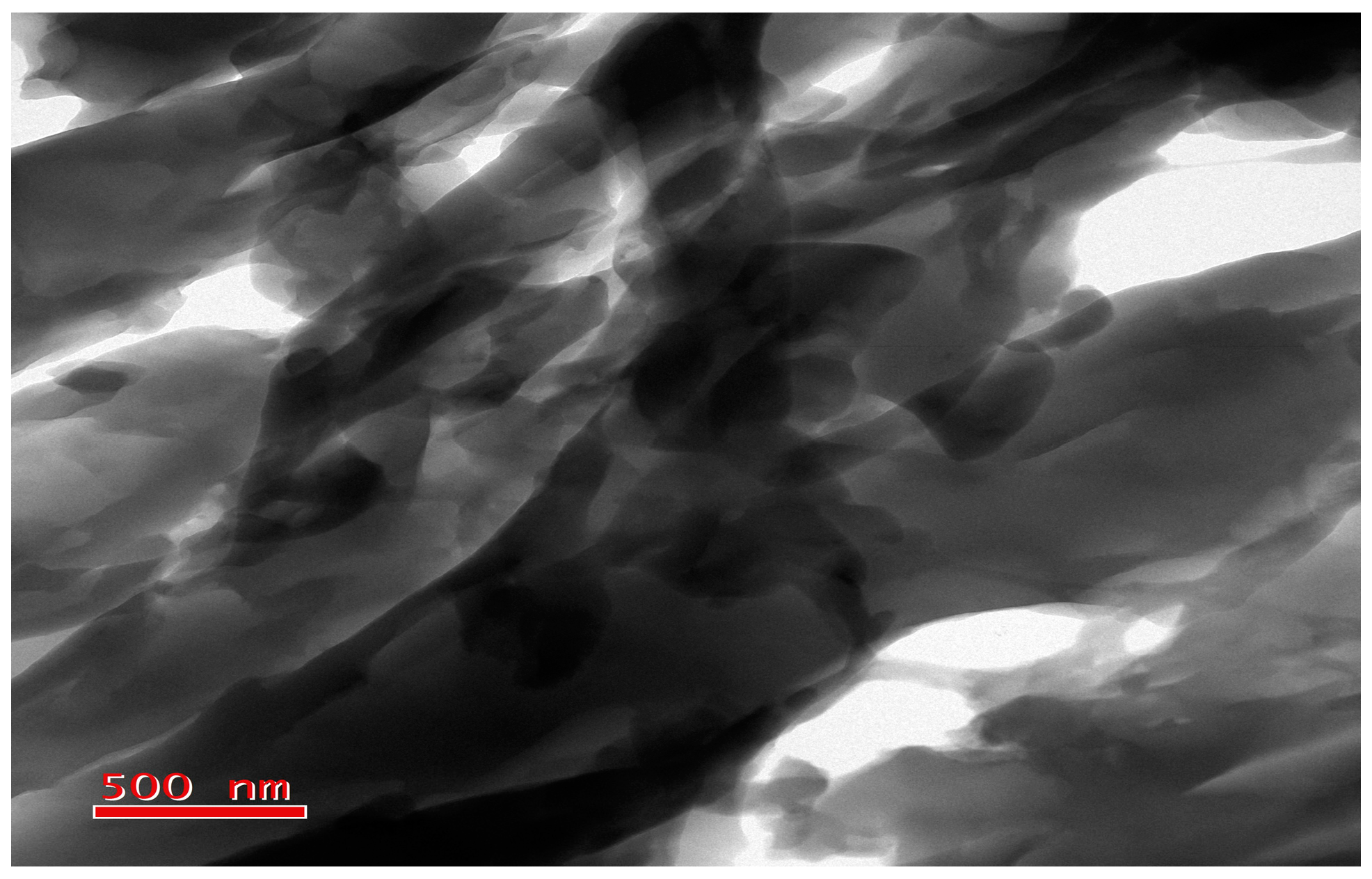
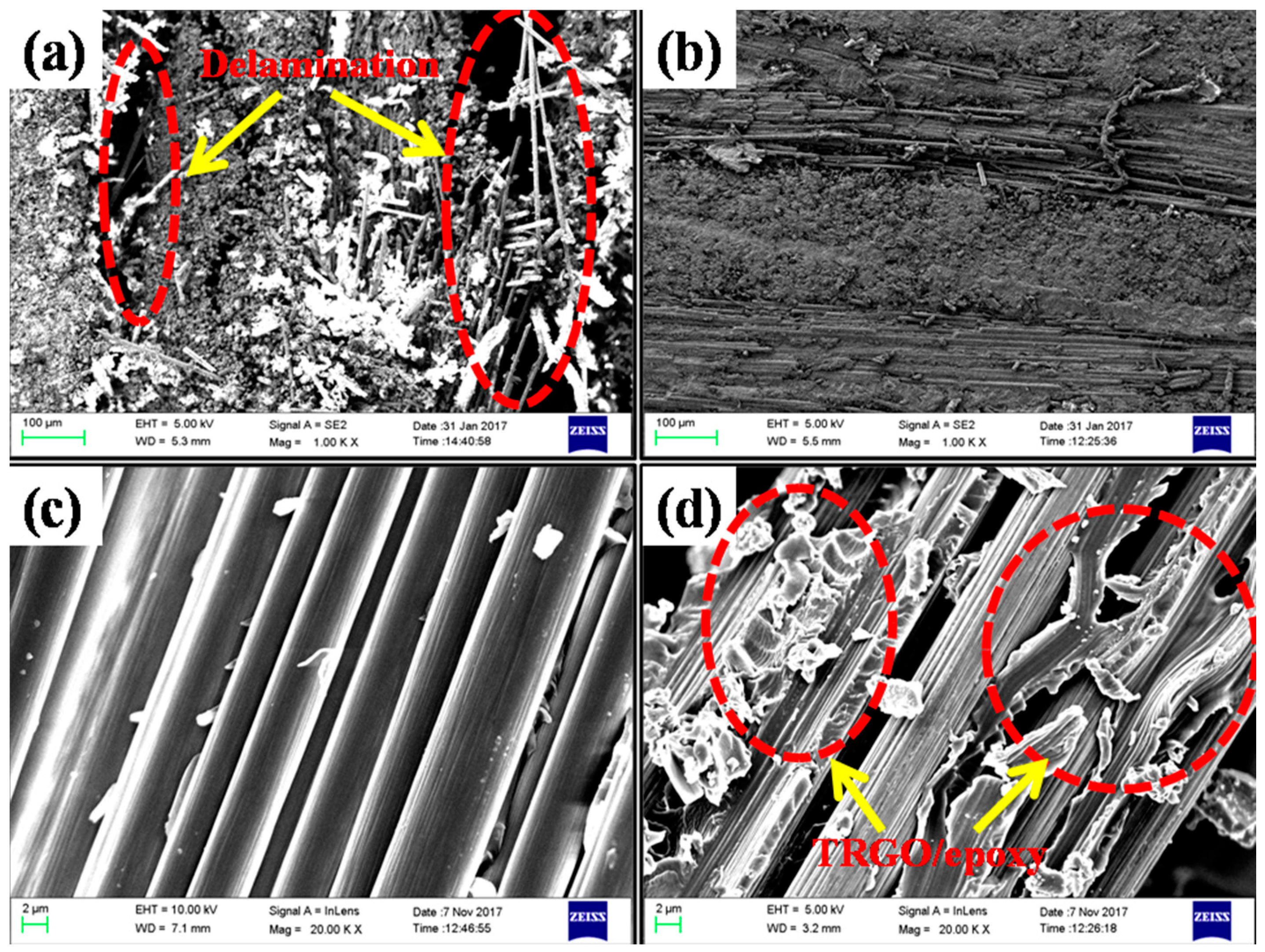
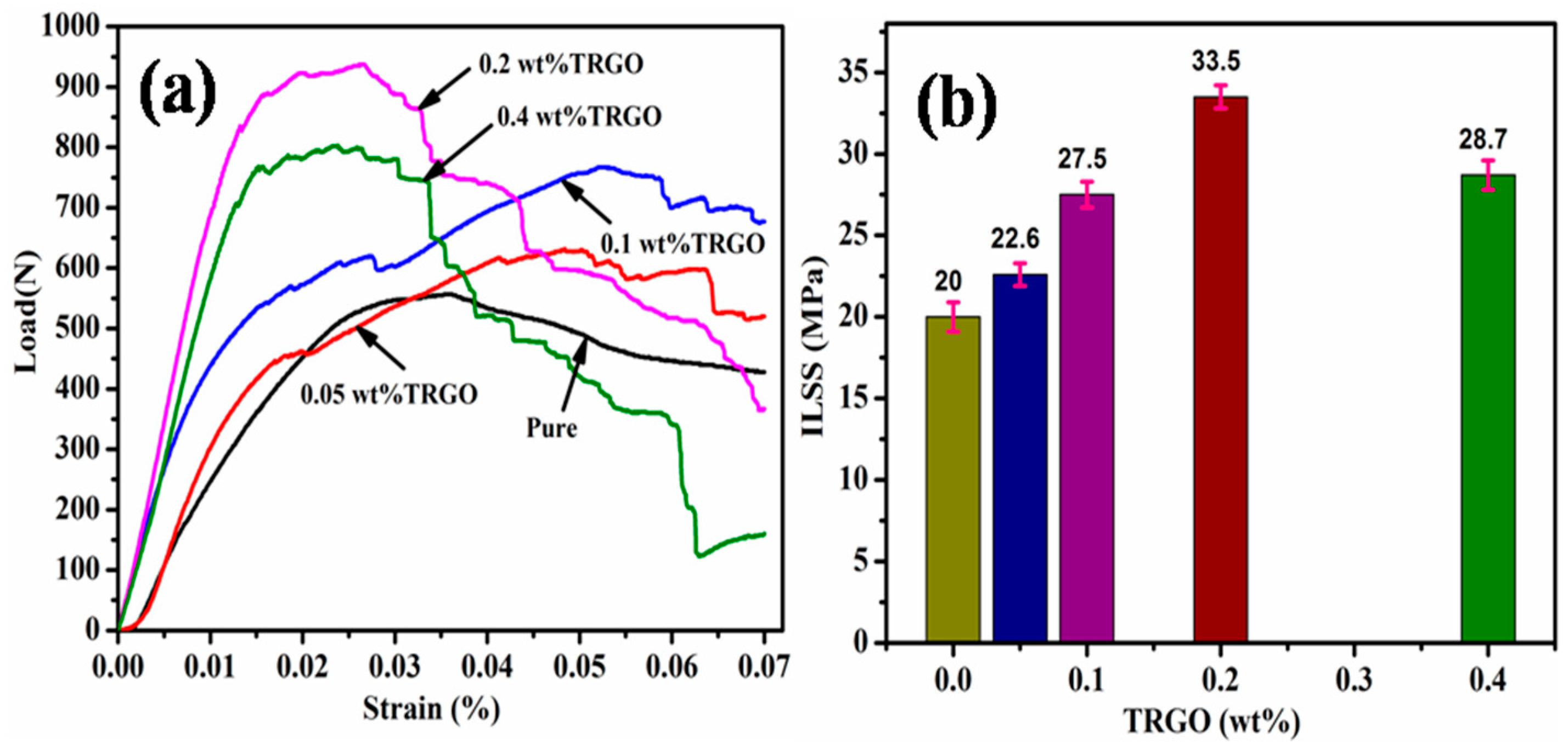
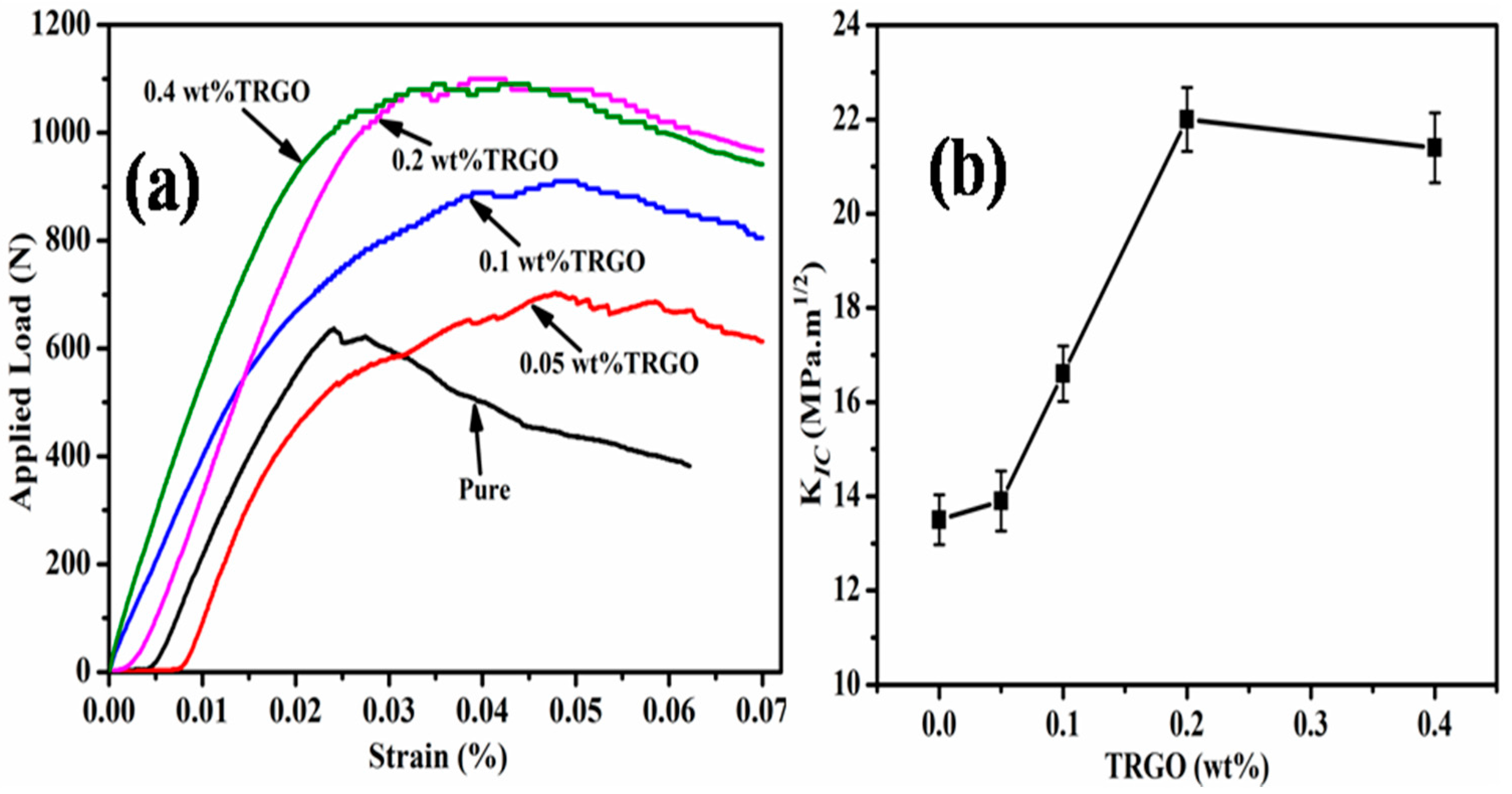
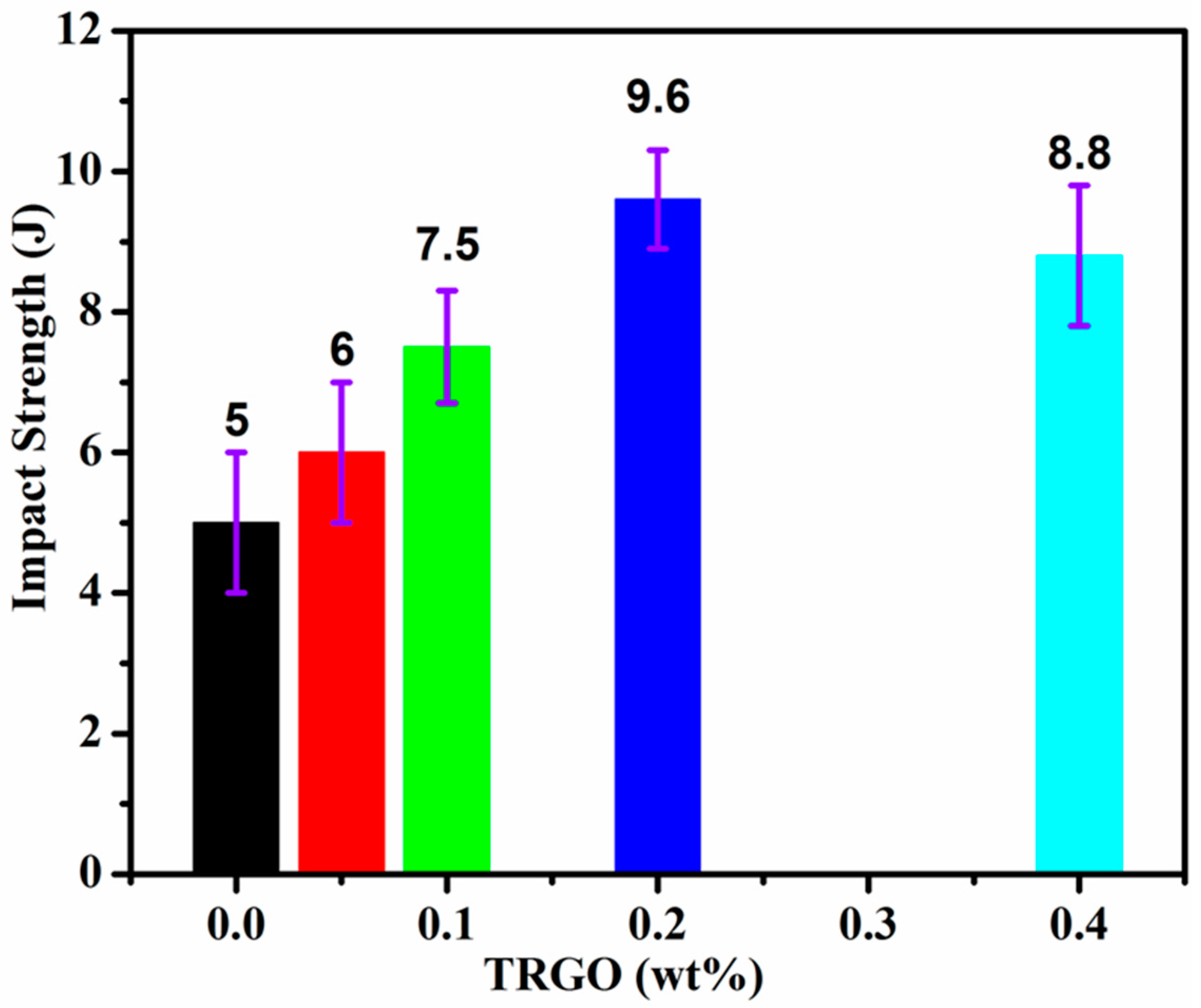
| wt % of TRGO | vf (%) | vm (%) | v0 (%) |
|---|---|---|---|
| 0 | 56 | 43 | 1 |
| 0.1 | 55 | 43.5 | 1.5 |
| 0.2 | 55 | 43.3 | 1.7 |
| 0.4 | 54 | 44 | 2 |
| wt % of TRGO | Pb (N) | ILSS (MPa) |
|---|---|---|
| 0 | 557 ± 25 | 20 ± 0.9 |
| 0.05 | 633 ± 20 | 22.6 ± 0.7 |
| 0.1 | 771 ± 22 | 27.5 ± 0.8 |
| 0.2 | 938 ± 20 | 33.5 ± 0.7 |
| 0.4 | 804 ± 25 | 28.7 ± 0.9 |
| wt % of TRGO | PQ (N) | KIC (MPa.m1/2) | GIC (J) |
|---|---|---|---|
| 0 | 635 ± 25 | 13.5 ± 0.53 | 685 |
| 0.05 | 654 ± 30 | 13.9 ± 0.64 | 1365 |
| 0.1 | 782 ± 28 | 16.6 ± 0.59 | 1526 |
| 0.2 | 1034 ± 32 | 22 ± 0.68 | 1782 |
| 0.4 | 1005 ± 35 | 21.4 ± 0.74 | 1680 |
© 2018 by the authors. Licensee MDPI, Basel, Switzerland. This article is an open access article distributed under the terms and conditions of the Creative Commons Attribution (CC BY) license (http://creativecommons.org/licenses/by/4.0/).
Share and Cite
Adak, N.C.; Chhetri, S.; Murmu, N.C.; Samanta, P.; Kuila, T. Effect of Thermally Reduced Graphene Oxide on Mechanical Properties of Woven Carbon Fiber/Epoxy Composite. Crystals 2018, 8, 111. https://doi.org/10.3390/cryst8030111
Adak NC, Chhetri S, Murmu NC, Samanta P, Kuila T. Effect of Thermally Reduced Graphene Oxide on Mechanical Properties of Woven Carbon Fiber/Epoxy Composite. Crystals. 2018; 8(3):111. https://doi.org/10.3390/cryst8030111
Chicago/Turabian StyleAdak, Nitai Chandra, Suman Chhetri, Naresh Chandra Murmu, Pranab Samanta, and Tapas Kuila. 2018. "Effect of Thermally Reduced Graphene Oxide on Mechanical Properties of Woven Carbon Fiber/Epoxy Composite" Crystals 8, no. 3: 111. https://doi.org/10.3390/cryst8030111
APA StyleAdak, N. C., Chhetri, S., Murmu, N. C., Samanta, P., & Kuila, T. (2018). Effect of Thermally Reduced Graphene Oxide on Mechanical Properties of Woven Carbon Fiber/Epoxy Composite. Crystals, 8(3), 111. https://doi.org/10.3390/cryst8030111




